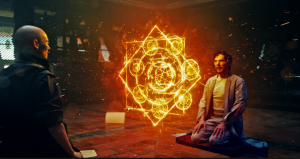TRIP SLAYMAKER ’18

ARTS AND ENTERTAINMENT EDITOR
In the landscape of movies in the year 2017, it’s astonishing how many superhero movies there are on the market. As the Western was the dominant craze in American film for a sizeable chunk of the twentieth century, the superhero film just will not slow down. The challenge, then, for any new adaptation of comic book superheroes, is to resist the fatigue, and find ways to stay new and entertaining in a rising tide of spandex.
“Doctor Strange” breaks the mold in a few obvious ways right off the bat. First- it is something of a stretch to call him a superhero at all. Stephen Strange (Benedict Cumberbatch) is a brilliant surgeon and medical pioneer with perfectly steady hands, and a dry and acerbic wit that can be traced pretty cleanly back to Robert Downey Jr.’s Tony Stark. Strange has a hubris problem, as is illustrated unsubtly by his habit of arrogantly diagnosing spinal injuries over speakerphone while driving his sports car. In a moment of what a more spiritual man might call “instant Karma,” Strange crashed and destroyed the nerves in both of his hands.
In a flashy and familiarly structured flurry of scenes, Strange begins down the path of a new life. We see that he has a strong will, a photographic memory, and lasting ties to a beautiful woman. Rachel McAdams is the physician, and love interest, Christine Palmer. Strange, unable to perform the surgical miracles that previously consumed his life, becomes depressed. Then, in a sudden leap of obsession, Strange abandons his girlfriend and follows an ostensibly meaningless piece of information let slip to him by one of his nurses. This takes him all the way to Tibet, where he encounters the Ancient One.
With almost no help, the ex-surgeon stumbles upon what is most expeditiously described as a wizard school. With the help of the supremely powerful Tilda Swinton in the role of the Ancient One, and the sturdy and respectable Mordo (Chiwetel Ejiofor), Strange learns about the hidden dimensions that border our own, and the intergalactic threats that are constantly at the door. He need only wave his hand, and a set of glowing, thrumming vfx letters and circles will appear, ready to be smashed into the heads of enemies.
None of this feels especially new, especially to regular viewers of the Marvel Universe. Strange is an overconfident albeit brilliant man who is humbled by a chance experience, and slowly arrives, scene by scene, at the status of superhero. This means a lot of scenes are explanatory; “what’s this book?” and “what’s this enchanted object?” type questions move Strange along through the complicated new worlds that magic can unlock. The exact second that Strange is magically proficient enough to fight a villain, he’s thrown into the ring with Mads Mikkelson’s Kaecilius. Mikkelson’s gothic mask of a face is accentuated by make-up and effects to look ominous. It does– and in the few fleeting scenes of stillness that feature Kaecilius, Mikkelson sharpens him up to the status of a moderately compelling villain, or at least one whose motivations aren’t so boring to be a distraction.
Once again, “Doctor Strange” takes the road more often travelled, and is left unfortunately lacking for the choice. But what it lacks in pure inspiration it makes up for in immersiveness, and incredible visuals. Future film historians may tie a red string between 2010’s “Inception” and “Doctor Strange”: each makes use of expensive and impressively mind-bending effects to portray a warped reality. This will likely be the only lasting legacy Strange has to offer- the effects really are breathtaking, but also derivative.
It isn’t a spoiler to say that, of course, Doctor Strange prevails and becomes a full-fledged superhero by the end of the movie. What is not as clear by the time credits are rolling is whether Doctor Strange passes as a real character. It’s his magical world that will be remembered more clearly.
Cinestudio Preview: Doctor Strange






+ There are no comments
Add yours